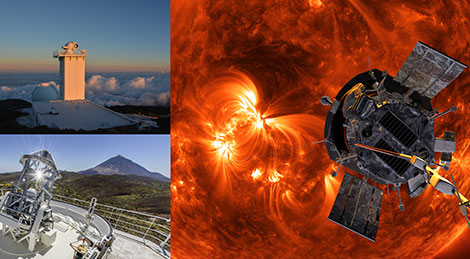Clockwise: The Swedish Solar Telescope (Credit: Dan Kiselman / Stockholm University); Artists impression of the Parker Solar Probe(Credit: Johns Hopkins University Applied Physics Laboratory); GREGOR (Credit: Daniel López / IAC).
If you would like to join the project, then you can send an expression interest to
or
The SST and GREGOR join seven other facilities in an effort to deliver an unprecedented view of coronal holes.
The SOLARNET Trans-national Access and Service (TAS) program is starting its second year of observational campaigns, with the GREGOR and the SST involved in acquiring data for a number of proposed projects. This year sees an ambitious effort to study the origin of high-speed winds streaming from the Sun and how they are accelerated to speeds in excess of a million kilometres per hour.
“It is long known that the high-speed solar wind originates within magnetic funnels, the building blocks of coronal holes”, says Stefan Hofmeister (Columbia University, USA), the PI of the campaign titled A holistic view on coronal holes. “However, the problem is that these magnetic funnels have never been distinctly identified.”
The planned observations bring together data from nine space and ground-based facilities in order to examine the individual open magnetic funnels in coronal holes, and how the solar wind flows out of them into the heliosphere. “In my opinion, the identification of the individual open magnetic funnels was, up to now, not possible as usually only a few instruments were involved in observing a single wind stream.” said Hofmeister. The planned observations will cover a vast distance, starting with data near the solar surface. The plan is to then follow the young wind out into the Sun’s corona, again sampling the solar wind streams at 15 solar radii, as it passes near Earth, and finally as it reaches Mars.
At the heart of the planned program are the high-resolution observations from the SST and GREGOR, which will provide insights into the magnetic field and dynamics in the chromosphere. Of interest to the science team is whether giant magnetic tornadoes, found in the chromosphere, contribute to the formation of the solar wind.
The European ground-based facilities will be joined by satellite observatories including the Parker Solar Probe, Hinode, IRIS, ACE & MAVEN. Furthermore, the Goode Solar Telescope and the Expanded Owens Valley Solar Array (EOVSA radio array) will complete the impressive list of facilities involved. “If one wants to prove that certain structures are the open magnetic funnels, this will require observations at several heights in the Sun’s atmosphere simultaneously. Being able to identify the open magnetic funnels would open a completely new window for studies of the acceleration of the solar wind.”
In addition to the challenges with such a pioneering study, observations will be impacted by the pandemic. “Of course, this will be a problem for all observations.” notes Dan Kiselman (Stockholm), who is leading the TAS programme, “There is a clear risk that observations may not take place as planned, but we are fighting to keep our facilities and the Access programme running.”
The proposed campaign is also breath-taking in the geographical scope and number of institutes that are currently involved. Stefan, who is the first non-EU-based PI to be granted access via the SOLARNET TAS program, said “We want this to be on purpose a larger-scale campaign where people from various communities collaborate. Therefore, everyone who wants to participate is welcome.”
The current list of institutes contains a number of SOLARNET partners, and includes: Columbia University, University of Alabama in Huntsville, HAO/National Center for Atmospheric Research, New Jersey Institute of Technology (USA); University of Southampton (UK); University of Graz (Austria); RoCS/University of Oslo (Norway); University of Zagreb (Croatia); Leibniz Institut for Astrophysik Potsdam, Max-Planck-Institut für Sonnensystemforschung (Germany); University of Helsinki (Finland); Royal Observatory of Belgium, KU Leuven (Belgium).
Written by Richard Morton (Northumbria University)

